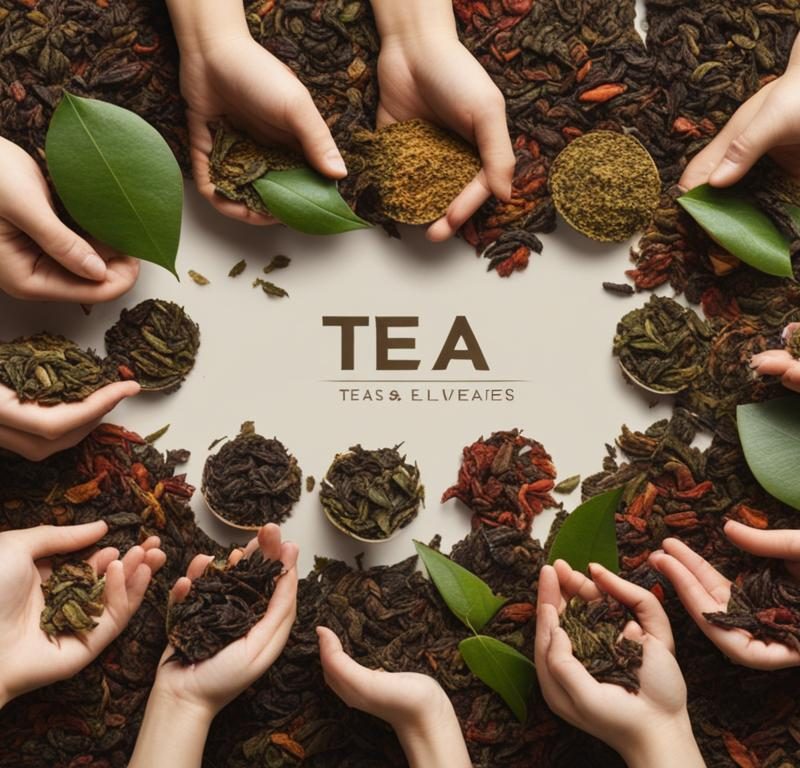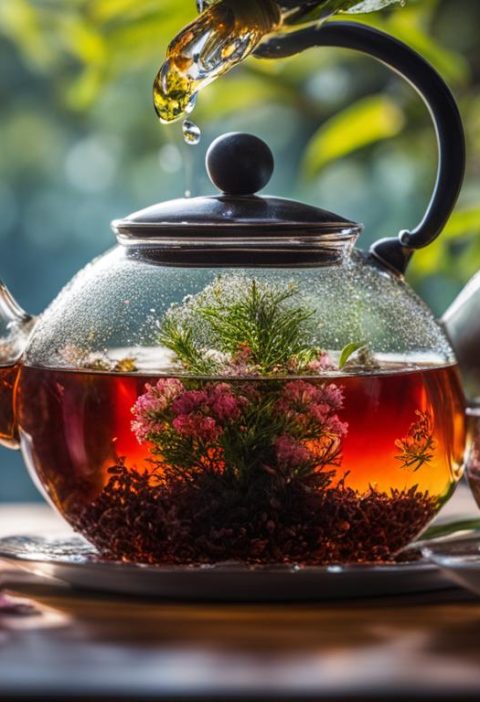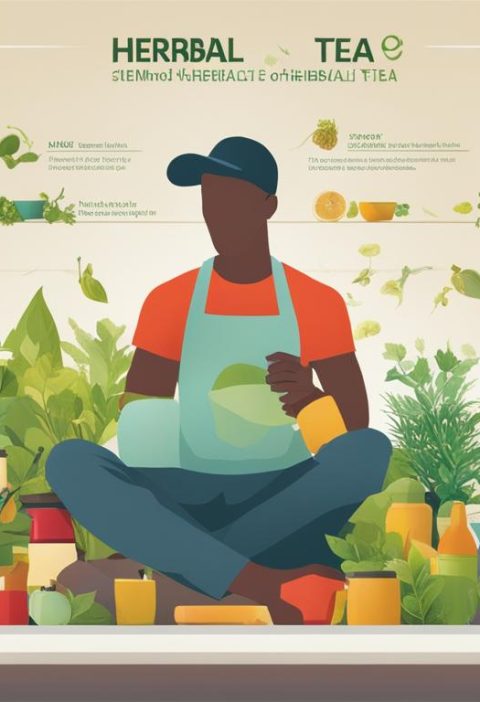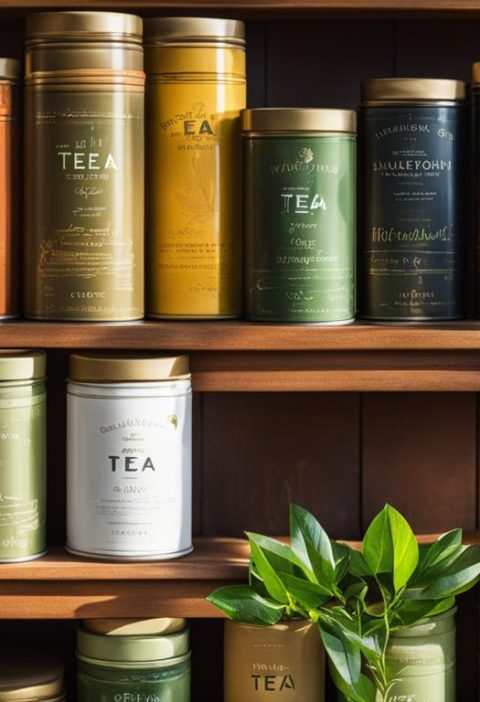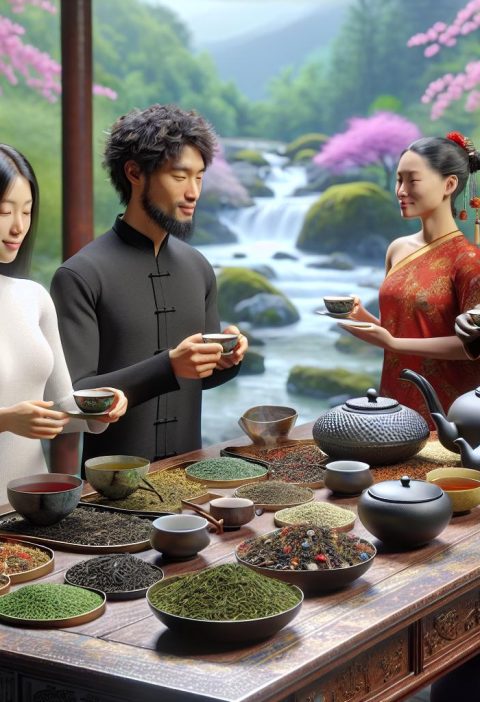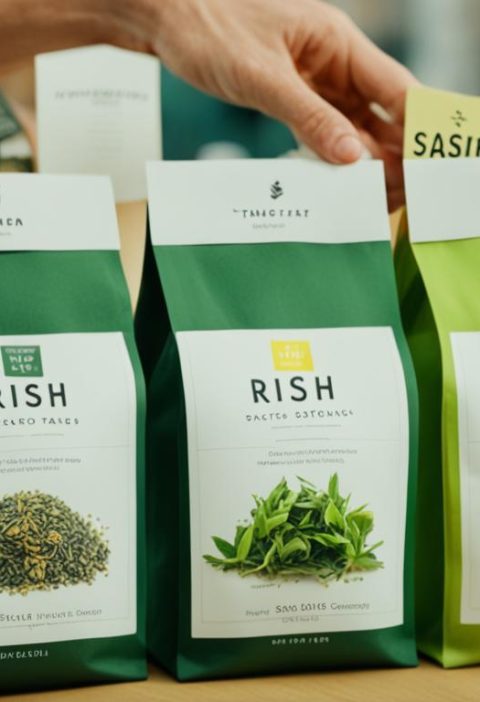In this comprehensive Beginner’s Guide to Tea Leaf Grading, we will explore the world of tea leaf grading and provide you with all the essential information you need to understand tea quality grades. From the basics of tea leaf classification to the intricacies of the tea grading system, we will cover it all. Whether you’re a beginner looking to enhance your tea expertise or a tea enthusiast wanting to deepen your knowledge, this guide is for you.
Tea leaf grading is a system used to classify and rank tea leaves based on their quality and characteristics. It plays a crucial role in determining the value and flavor profile of different teas.
Key Takeaways:
- Tea leaf grading is essential for understanding tea quality grades and making informed choices.
- The tea leaf grading system categorizes tea leaves based on their size, appearance, and quality.
- Understanding tea leaf appearance can provide insights into the freshness and integrity of the tea.
- Multiple factors, such as terroir and processing methods, influence tea leaf grading.
- Grading tea leaves requires visual assessment and sensory evaluation techniques.
What is Tea Leaf Grading?
Tea leaf grading is a system used to classify and rank tea leaves based on their quality and characteristics. It plays a crucial role in determining the value and flavor profile of different teas. Understanding tea grades is important for tea enthusiasts as it allows them to make informed choices when selecting and purchasing their preferred teas.
Tea leaf grading assigns a specific grade to a particular tea based on criteria such as leaf appearance, size, and quality. The grading system varies across different tea-producing regions, reflecting the unique characteristics and standards of each region.
The importance of tea grading lies in its ability to convey valuable information about a tea’s overall quality and flavor. By understanding tea grades, consumers can gauge what they can expect from a particular tea and select the one that aligns with their taste preferences.
Furthermore, tea leaf grading enables tea producers and sellers to establish a standardized pricing structure based on the quality of the tea. This ensures transparency and consistency in the tea market, allowing consumers to navigate the vast array of tea options with confidence.
In the next section, we will delve into the details of tea leaf grading and its significance in the tea industry.
The Tea Leaf Grading System
The tea leaf grading system plays a vital role in categorizing and assessing the quality of tea leaves. It consists of various grades and terminology that classify tea based on size, appearance, and overall quality. While the specific grading system may vary among different tea-producing regions, each region establishes its own set of standards.
This system enables tea enthusiasts to appreciate and evaluate the quality of teas by understanding the significance of different tea grades. Let’s explore the types of tea grades, their meanings, and how they contribute to the art of tea grading.
The Types of Tea Grades
Tea grades encompass a range of classifications that help differentiate the quality and characteristics of tea leaves. Here are some common types of tea grades:
- Whole Leaf Grades: Represented by long, unbroken tea leaves that are usually of higher quality
- Broken Leaf Grades: Composed of tea leaves that are broken or partially fragmented, resulting in a different flavor profile
- Fannings: Small, fine tea particles often used in tea bags
- Dust: Fine particles, usually the smallest grade, commonly used in tea bags
- Twisted Grades: Tightly twisted tea leaves, often indicative of higher quality
These are just a few examples of the diverse tea grades and their characteristics. Let’s dive deeper into the terminology used in tea leaf grading.
Tea Grading Terminology
The tea grading terminology provides a standardized language for describing and differentiating tea leaves. Here are some common terms you may encounter:
| Term | Meaning |
|---|---|
| OP | Orange Pekoe; refers to a larger and more open tea leaf, not necessarily flavored with orange |
| TGFOP | Tippy Golden Flowery Orange Pekoe; indicates that the tea includes golden tips and is of high quality |
| BOP | Broken Orange Pekoe; denotes a tea with broken leaves but still maintains its distinctive flavor |
| SFTGFOP | Super Fine Tippy Golden Flowery Orange Pekoe; the finest grade of tea, often handpicked |
Understanding these terms and their meanings enhances your ability to appreciate and select teas based on your preferences. It’s important to note that the grading system may vary depending on the tea-producing region and individual tea gardens.
Understanding Tea Quality Grades
When it comes to assessing the quality of tea, understanding tea quality grades is essential. Tea quality grades are determined by various factors, including the size, shape, color, and texture of the tea leaves. These characteristics provide valuable insights into the level of freshness, aroma, flavor, and overall quality of the tea.
High-quality tea leaves possess distinct characteristics that set them apart from lower-grade teas. The following are key factors that determine tea grades:
- Size: The size of the tea leaves plays a significant role in determining their grade. Whole leaf teas, such as those with intact, unbroken leaves, are often considered higher quality compared to broken leaf teas.
- Shape: The shape of tea leaves can indicate the level of craftsmanship and processing. Well-shaped leaves are generally preferred as they reflect careful handling and attention to detail during production.
- Color: The color of tea leaves can vary depending on the type of tea and its processing. However, high-quality tea leaves tend to exhibit vibrant and consistent colors that are indicative of their quality.
- Texture: The texture of tea leaves, ranging from smooth to rough, can provide insights into their quality. High-quality tea leaves often have a smooth, velvety texture, which enhances the brewing experience.
By assessing these factors, tea experts and enthusiasts can evaluate the quality of tea leaves and assign them appropriate grades. High-quality tea leaves are typically given higher grades, indicating their superior attributes and resulting in a more enjoyable tea-drinking experience.
To help you visualize the characteristics of high-quality tea leaves, take a look at the image below:
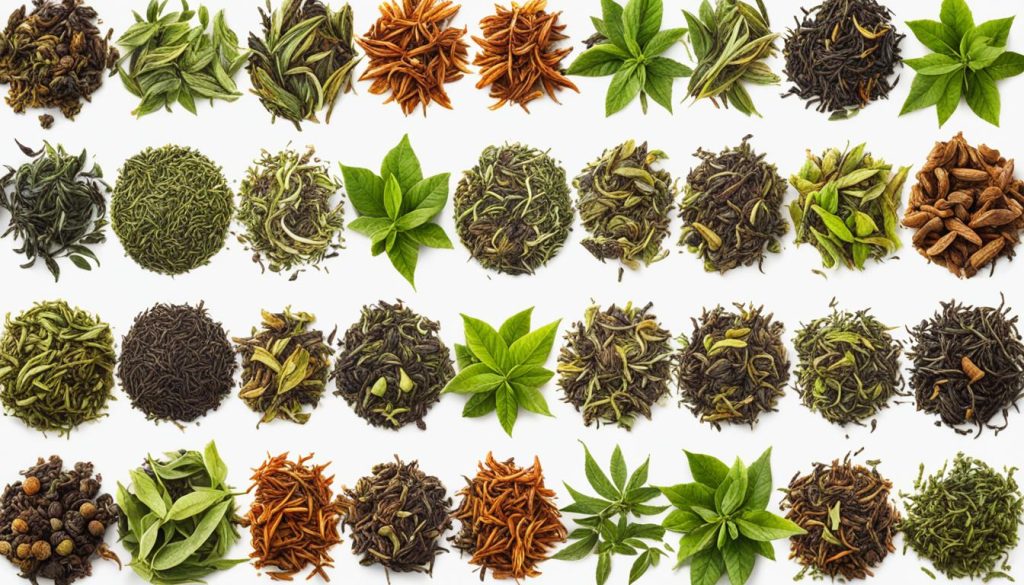
This image showcases the vibrant color, intact shape, and smooth texture of high-quality tea leaves. By observing these qualities, tea enthusiasts can gain a better understanding of what to look for when selecting premium teas.
The Importance of Tea Leaf Appearance
The appearance of tea leaves is a crucial aspect when assessing the quality of tea. Just like we judge a book by its cover, we can gain valuable insights into the tea’s freshness and integrity by examining its visual characteristics. Tea drinkers have long relied on visual cues to determine the overall quality of tea leaves.
When visually assessing tea leaves, there are several key factors to consider:
- Size: The size of tea leaves can provide clues about their maturity and flavor. Smaller leaves are often prized for their delicate flavors, while larger leaves may offer a bolder taste.
- Shape: The shape of tea leaves can vary greatly, from tightly rolled balls to long, twisted strands. The shape can indicate the processing method used and may impact the tea’s infusion and flavor.
- Color: Tea leaves come in a wide range of colors, from vibrant greens to deep browns. The color can reflect the tea’s oxidation level and freshness. For example, green tea leaves are minimally oxidized and often have a bright green color.
- Consistency: Examining the consistency of tea leaves involves observing how uniform they are in shape, size, and color. Consistent leaves suggest careful processing and handling, while inconsistencies may indicate lower quality.
By paying attention to these visual cues, tea enthusiasts can make better-informed choices when selecting their preferred teas. The appearance of tea leaves can also enhance the overall tea-drinking experience, as visually pleasing leaves often translate to a more enjoyable brew.
In the next section, we will delve deeper into the factors that influence tea leaf grades and explore the impact of terroir and processing methods on tea quality.
Factors Affecting Tea Leaf Grade
Tea leaf grading is a meticulous process that takes into account several factors to determine the overall quality and grade of tea leaves. In this section, we will explore the key factors that influence tea leaf grading, including the influence of terroir on tea quality and the impact of processing methods on tea grading.
Influence of Terroir on Tea Quality
Terroir, referring to the environmental conditions in which tea plants grow, plays a significant role in shaping the flavor and quality of tea. Factors such as climate, soil composition, altitude, and surrounding vegetation all contribute to the unique character of tea grown in a specific region.
For example, tea cultivated in the misty highlands of Darjeeling in India has a delicate and floral flavor profile, thanks to its cool temperatures and mountainous terrain.
Similarly, teas from different regions around the world, such as Assam in India, Yunnan in China, and Uva in Sri Lanka, each have distinct flavor profiles and characteristics influenced by their respective terroirs.
Impact of Processing Methods on Tea Grading
The way tea leaves are processed after harvest also greatly affects their final grade. Various processing methods, such as oxidation, rolling, firing, and drying, are employed to bring out the desired flavors and aromas in the tea leaves.
Oxidation, for instance, is a crucial step in the production of black teas. The length of oxidation determines the intensity and complexity of the tea’s flavors and influences its eventual grade.
Teas like oolong and green teas undergo different levels of oxidation, resulting in distinct flavor profiles. Oolong teas are partially oxidized, offering a wide range of flavors from floral to fruity, while green teas are minimally oxidized, giving them a fresh and grassy taste.
The rolling technique used during processing also impacts tea grading. The degree of rolling affects the leaf appearance, which can be an essential criteria for determining tea grade.
| Factors Affecting Tea Leaf Grade | Influence |
|---|---|
| Terroir | Climate, soil conditions, altitude, and surrounding vegetation |
| Processing Methods | Oxidation, rolling, firing, and drying techniques |
By understanding these factors that affect tea leaf grade, tea enthusiasts and professionals can appreciate the complexities and nuances of different teas. The combination of terroir and processing methods results in an array of tea varieties with varying flavors, aromas, and quality.
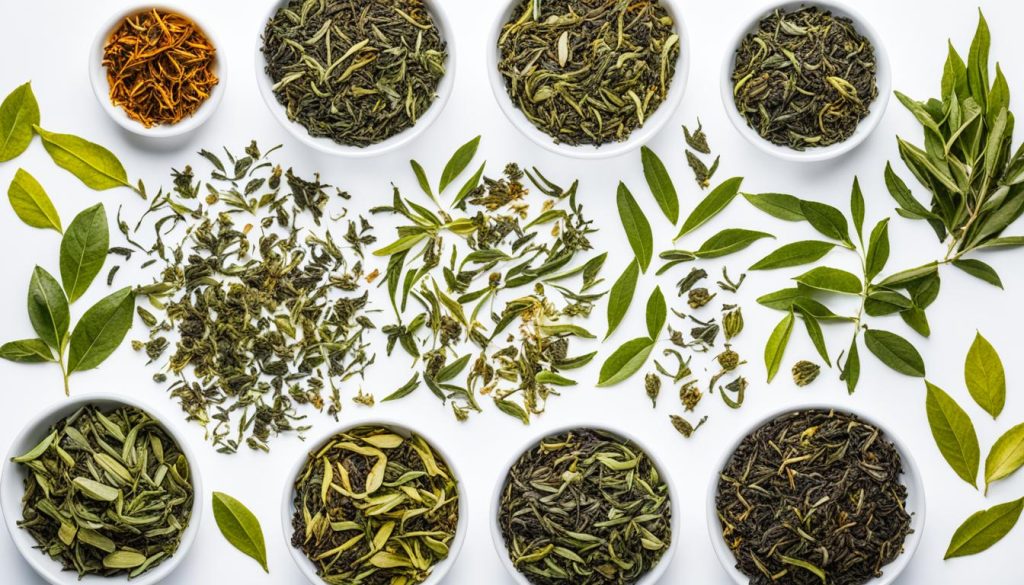
Common Tea Grades and Their Characteristics
Tea grades play a vital role in determining the quality and characteristics of different teas. Understanding the nuances of common tea grades can help tea enthusiasts make informed choices and discover their preferred flavors. In this section, we will explore some popular tea grades and their unique characteristics that set them apart.
Whole Leaf Grades
Whole leaf grades, also known as whole leaf teas, are highly regarded for their quality and flavor. These teas consist of intact, unbroken leaves, often handpicked and carefully processed to preserve their natural beauty and flavors. Whole leaf grades are known for their complex flavors, delicate aromas, and well-balanced profiles.
Broken Leaf Grades
Broken leaf grades, as the name suggests, are made up of tea leaves that have been broken into smaller pieces during processing. These teas offer a robust and strong flavor profile, with a quicker infusion time compared to whole leaf grades. Broken leaf grades are often favored in traditional brewing methods, such as English breakfast teas.
Fannings and Dust
Fannings and dust grades consist of small, finely ground tea particles that are ideal for quick brewing methods like tea bags. These grades are known for their strong, bold flavors and are often used in the production of mass-market tea products. While they may lack the complexities of whole leaf and broken leaf grades, fannings and dust grades provide a convenient and accessible tea experience.
There are many other tea grades available, each with its own unique characteristics. By exploring the diverse range of tea grades, you can discover your preferred flavor profiles and expand your tea tasting journey. The next section will guide you on how to grade tea leaves and assess their quality.
How to Grade Tea Leaves
Grading tea leaves is a skill that requires a combination of visual assessment and sensory evaluation techniques. By understanding the factors that determine tea quality, you can confidently assess the leaves and make informed choices when purchasing tea. To help you on your tea grading journey, we have outlined a step-by-step guide:
-
Step 1: Visual Assessment
Begin by examining the appearance of the tea leaves. Look for leaves that are whole, unbroken, and have a consistent size. High-quality leaves should have a vibrant color and exhibit a delicate, unblemished appearance. -
Step 2: Aroma Evaluation
Next, focus on the aroma of the tea leaves. Take a deep breath and inhale the fragrance. High-quality tea leaves will emit a pleasant and distinct aroma that is indicative of the type of tea and its freshness. -
Step 3: Leaf Infusion
To further assess the quality of the tea leaves, it is essential to observe their behavior during infusion. Add a specified amount of leaves to hot water and observe how they unfurl and release flavor. The leaves should unfurl uniformly and retain their shape, indicating a higher grade. -
Step 4: Taste Evaluation
Finally, taste the brewed tea. Pay attention to the flavor profile, noting any nuances, complexity, or balance. High-quality tea leaves will result in a refined, enjoyable taste with no bitterness or astringency, leaving a pleasant aftertaste.
By following these steps, you can develop your tea grading skills and confidently assess the quality of tea leaves. Remember, practice and experience play crucial roles in becoming proficient in grading tea. Now, let’s put our knowledge into practice by exploring a detailed table that showcases the characteristics of different tea grades:
| Tea Grade | Characteristics |
|---|---|
| Whole Leaf Grade | Long, unbroken tea leaves with minimal or no tips. Vibrant color, delicate appearance, and pronounced aroma. |
| Broken Leaf Grade | Slightly smaller leaves, broken or chopped. More robust flavor compared to whole leaf grades. |
| Fannings Grade | Smaller leaf particles, often used in tea bags. Quick infusion and strong, robust flavor. |
| Dust Grade | Smallest grade, consisting of fine tea particles. Used in tea bags or instant tea. Quick infusion and strong flavor. |
As illustrated in the table above, different tea grades possess distinctive characteristics that influence their flavor and brewing properties. Understanding these characteristics will empower you to choose teas that align with your preferences.
Now that you know how to grade tea leaves and have familiarized yourself with the characteristics of various tea grades, you are well-equipped to explore the world of tea with confidence and appreciation for its quality. So go ahead, indulge in the exquisite flavors and aromas that tea has to offer!
Tea Leaf Grading Criteria
Tea leaf grading criteria play a crucial role in assessing the quality of tea leaves. Professionals and experts in the tea industry rely on these criteria to evaluate and grade teas accurately. Understanding the key factors that contribute to tea grading is essential for tea enthusiasts and connoisseurs alike. Let’s explore the important tea leaf grading criteria and their significance in determining tea quality.
Leaf Size
The size of tea leaves is an important factor in grading. Larger, whole tea leaves are generally considered to be of higher quality, as they often indicate a more delicate flavor profile and a greater potential for infusing multiple times.
Leaf Shape
The shape of tea leaves can vary widely, from long and slender to tightly rolled or twisted. Different shapes can affect the steeping time and the release of flavors during brewing. The visual appearance of tea leaves also contributes to the overall aesthetic appeal of the tea.
Leaf Color
The color of tea leaves can provide valuable information about the processing and oxidation levels. For example, green teas are known for their vibrant green color, while black teas have darker, coppery tones. The color can influence the taste and aroma of the tea.
Aroma
The aroma of tea leaves is a critical aspect of grading. The scent can range from floral and vegetal notes to more complex and aromatic profiles. A fragrant aroma often indicates higher quality and freshness.
Flavor
The taste and flavor profile of brewed tea is an essential consideration in tea grading. The flavors can vary from sweet and floral to robust and earthy, depending on factors such as tea type, processing techniques, and origin. A balanced and distinct flavor profile is often indicative of superior tea quality.
Overall Appearance
The overall appearance of tea leaves includes factors such as cleanliness, uniformity, and absence of imperfections. Tea leaves with a visually appealing appearance are considered more desirable and are often associated with higher quality.
By carefully assessing and evaluating these tea leaf grading criteria, tea professionals and enthusiasts can gain valuable insights into the quality and characteristics of different teas. Understanding these factors empowers tea lovers to make informed decisions when selecting and enjoying their preferred teas.
Enhancing Your Tea Expertise
To become a tea expert, it is essential to continuously enhance your understanding and knowledge of tea grading. This involves honing your sensory evaluation skills, familiarizing yourself with different tea grades and their characteristics, and staying updated with industry trends and developments.
1. Hone Your Sensory Evaluation Skills
Sensory evaluation is a crucial aspect of tea grading. To improve your ability to assess tea quality based on sensory factors, such as aroma, flavor, and appearance, consider the following:
- Regularly taste a variety of teas to train your palate and develop a vocabulary to describe different flavor profiles.
- Pay attention to the aroma of teas by inhaling deeply before each sip, noting any distinct scents and their intensity.
- Observe the appearance of tea leaves, noting their color, shape, and uniformity.
2. Familiarize Yourself with Different Tea Grades
Deepening your knowledge of tea grades is essential for understanding the nuances of tea quality. Take the time to study different tea grades and their characteristics, such as the leaf size, color, and texture. This will enable you to identify and appreciate the unique qualities of each grade.
3. Stay Updated with Industry Trends and Developments
The tea industry is constantly evolving, with new techniques, technologies, and trends emerging. Stay connected with tea experts, industry publications, and tea communities to stay informed about the latest advancements in tea grading. Attend tea conferences, workshops, and seminars to expand your knowledge and network with fellow tea enthusiasts.
Conclusion
In conclusion, tea leaf grading is a complex system that allows tea enthusiasts to evaluate and appreciate the quality of tea leaves. By understanding the tea grading system, the factors that influence tea grades, and the criteria used for assessing tea quality, you can make informed choices when selecting and purchasing teas.
This beginner’s guide to tea leaf grading has provided you with valuable insights and resources to enhance your tea expertise. From understanding the importance of tea leaf appearance to learning about the factors that affect tea leaf grade, you now have the knowledge to confidently assess the quality of tea leaves.
So, next time you’re shopping for tea, take a closer look at the grading information and let your newfound knowledge guide you in choosing the perfect brew. Whether you prefer a delicate white tea or a robust black tea, the tea grading system is there to help you find the tea that suits your taste preferences. Happy tea grading!
